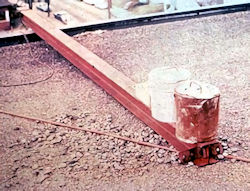22.E.07 Outrigger beams.
- Outrigger beams must be made of structural metal and must be restrained to prevent movement.
- The inboard ends of outrigger beams must be stabilized by bolts or other direct connections to the floor or roof deck, or they must have their inboard ends stabilized by counterweights, except mason's multiple point adjustable suspension scaffold outrigger beams must not be stabilized by counterweights.
- Before use, direct connections must be evaluated by a CP who must affirm that the supporting surfaces are capable of supporting the loads to be imposed. Mason's multiple point adjustable suspension scaffold connections must be designed by a RPE experienced in scaffold design.
- Counterweights must be made of non-flowable solid material, must be secured to the outrigger beams by mechanical means, and must not be removed until the scaffold is disassembled.
- Outrigger beams must be secured by tiebacks equivalent in strength to the suspension ropes. Tiebacks must be secured to a structurally sound portion of the building or structure and must be installed parallel to the centerline of the beam.
- Outrigger beams must be provided with stop bolts or shackles at both ends.
- When channel iron beams are used in place of I-beams, the channels must be securely fastened together with the flanges turned outward.
- Outrigger beams must be installed with all bearing supports perpendicular to the beam centerline.
- Outrigger beams must be set and maintained with the web in a vertical position.
- Where a single outrigger beam is used, the steel shackle or clevises with which the wire ropes are attached to the beam must be placed directly over the hoisting machines.
22.E.08 Hoisting machines
Hoist Operation - Skyclimber.
- Hoisting machines must be of a type tested and listed by a nationally recognized testing laboratory.
- Each hoist must contain a name plate(s) containing:
- (1) Manufacturer's name;
- (2) Maximum load rating;
- (3) Identification number; and
- (4) Wire rope specifications.
- Powered hoists must be electric-, air-, hydraulic-, or propane-powered. Gasoline-powered hoists are prohibited.
- All powered hoists must be equipped with speed reducers and must be provided with a primary brake and a secondary brake.
- (1) The primary brake must automatically engage whenever power is interrupted or whenever the operator ceases to apply effort;
- (2) The secondary brake must stop and hold the hoist under over speed or abnormal conditions. All secondary brakes must be periodically tested under simulated conditions in accordance with the manufacturer's recommendations.
- Each powered hoist must have its own separate control.
- (1) If the control is of the push-button type, it must be constant pressure;
- (2) If the control is of the fixed-position type, it must have provision for automatic locking when in the off position, or must be guarded against accidental actuation; and
- (3) If the control is of the lever type, it may be of the constant pressure type or of the fixed-position type.
- Manual operation of powered hoists may be provided if the hoist is designed so that not more than one person per hoist is required to perform this operation.
- (1) During manual operation, a means must be provided to make the prime mover inoperative.
- (2) Instruction must be provided advising personnel to disconnect the power source before using a manual crank.
- Manually-operated hoists.
- (1) Manual operation must provide a means to prevent rapid handle movement or fast un-spooling. Mechanisms used to allow fast un-spooling during the erection process must not be in place on the scaffold.
- (2) In the event a controlled descent device is used, it must not bypass the secondary brake.
- (3) All winding drum hoists must be provided with a driving pawl and a locking pawl that automatically engages when the driving pawl is released.
- (4) Gripping-type hoists must be designed so that the hoist is engaged on the suspension rope at all times, including all travel actuations of the operating lever.
- (5) Each winding drum hoist must be provided with a positive means of attachment of the suspension hoist. The drum attachment must develop a minimum of four times the rated capacity of the hoist.
- (6) Each hoist must require a positive crank force to descend.
Knowledge Check Choose the best answer for the question.
22-8. Which of the following is NOT approved for powering hoists?
You forgot to answer the question!

